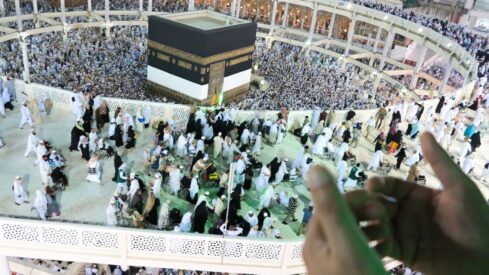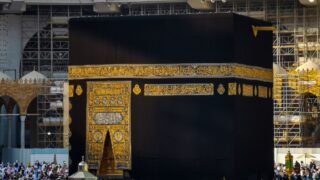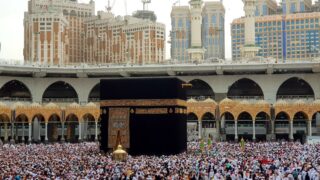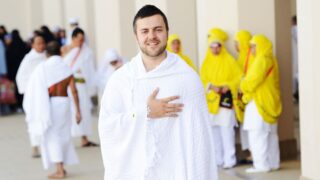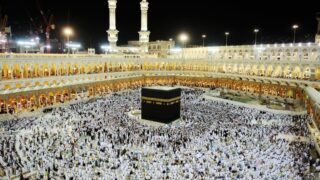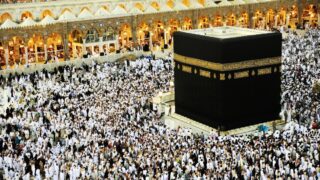The Kabah in Makkah is the first house built on earth for the worship of the One and Only God of the universe.
Religious pilgrimages usually derive their importance from their connection to the birth or death or burial of a prophet or a saint. There is indeed a general misunderstanding among people that hajj (Muslims’ pilgrimage) gets its importance from Makkah as the birth place of Prophet Muhammad (peace be upon him). However, the facts tell us a different story:
The Kabah in Makkah is the first house built on earth for the worship of the One and Only God of the universe. The Last Prophet Muhammad was born in the same place where the Kabah stands, in answer to the prayer of the grand patriarch, Prophet Abraham (peace be upon him).
Indeed, the rituals of hajj-such as the circumambulation of the House, running between the two mounts Safa and Marwah, and animal sacrifice – owe more to the life and example of Prophet Abraham, his wife Hajar and his son Ishmael, than to Prophet Muhammad.
In hajj, the pilgrims try to emulate Prophet Abraham and his family by re-enacting some of their acts of obedience and sacrifice. Every time during the five times’ ritual prayer, Muslims far and near turn towards the Sacred House at Makkah where the Kabah stands. And once every year during hajj, pilgrims coming from the far corners of the planet cross the seas and deserts to congregate towards that Centre.
Once they reach there, the first thing they do is to go in a circle whose centre is the Kabah, which performs “an essential existential function by providing orientation in an otherwise disoriented world.” (Robinson) Muslims consider the Kabah as the Center of the whole earth as it symbolizes the Oneness of Allah Almighty – the Only God deserving of worship and unconditional obedience.
Islam is unique in that as it does not allow the worship of any creation of God, whether human, animal or material.
According to Mircea Eliade, the well-known religious philosopher, religious man needs to found his world by finding in it a fixed center. Indeed, he calls such a center, “the Center of the World” and “the Navel of the Earth”, expressions he might have borrowed from the Muslim tradition of hajj.
In fact, the circumambulation of the House (Tawaf) has great mystic significance. It is a practical demonstration of the Muslim belief in the oneness of God (tawhid).
For the believers, the Kabah exerts a strong spiritual pull on them, which urges them to move towards it and become a part of the never-ending circles of humanity slowly moving around it.
The circumambulation around the Kabah, starts from the Black Stone situated on one corner of the cube-like structure. The pilgrims are to kiss this stone if possible, or if that is not possible in the crowd, gesture towards it – to note the number of times they circle the Kabah.
That is to say, the Black Stone is a sort of a marking stone, placed in a corner from where the pilgrims begin the circumambulation. This stone was placed there when the Kabah was originally built.
Even though the cubical structure of the Kabah was rebuilt a number of times in history, this particular corner stone was not replaced, as it represented the original house of worship built on earth to worship the One and Only God of the universe.
The place between the door of the Kabah and the Black Stone is called Al-Multazam. The pilgrims are well advised to offer supplications there. Because Muslims believe that this is one of the places where supplications are to be answered.
After the circumambulation, and the prayer at Maqam Abraham, the pilgrims move to Zamzam.
The origin of Zamzam water is well-known: As the infant Ishmael cried out in thirst, his mother Hajar ran repeatedly back and forth between the hills of Safa and Marwah in the hope of finding water. As the baby cried, his feet rubbed the sand where miraculously, a spring bubbled out. Thus it was that the well of Zamzam was created. This well has never run dry, and its water has always maintained a very distinctive taste. After drinking from Zamzam water, the pilgrims move towards the mounts of Safa and Marwah to retrace the steps of Hajar in search of water.
On Dhul-Hijjah 8, people gather in a place called Mina and prepare to move to the mount of Arafat the next day. Prophet Muhammad has equated hajj with Arafah, meaning that the essence of hajj is standing on the mount of Arafat on the 9th of Dhul-Hijjah, Indeed, there is no other center of pilgrimage that unites at one place, so many humans of so many different races, nationalities and languages to participate in the same religious rites.
The Hajj, in which all marks of social distinction are wiped out, presents the unity of humanity: Malcolm X, the charismatic African-American Muslim leader wrote: America needs to understand Islam, because this is the one religion that erases from its society the race problem….I have never before seen sincere and true brotherhood practiced by all colors together, irrespective of their colors. You may be shocked by these words coming from me. But on this pilgrimage, what I have seen, and experienced, has forced me to re-arrange much of thought-patterns previously held, and to toss aside some of my previous conclusions. (Haley 340)
Certainly the culmination of the hajj is on the day of Arafah. That is the “standing” in the valley of Arafah on Dhul Hijjah 9. At Arafah the believer has the higher spiritual experience of standing in Divine Presence. Here between the earth and sky, there is nothing to make him feel that he is away from his Creator. Standing in the midst of a sea of humanity eagerly “desiring the Face of God”, the pilgrim feels completely transformed by the experience of Divine Presence. Prophet Muhammad said,
“There is no day on which Allah frees more of His slaves from Fire than the Day of Arafah, and He verily draws near, then boasts of them before the angles, saying: “What do they seek?” (Muslim).
After Arafah, pilgrims move towards a place called Muzdalifah which is between Mina and Arafah and stay there for the night. From there, the pilgrims move to Mina valley to throw stones at the three Jamrahs. After the stoning of the Jamarat, the slaughter of animals and the circumambulation of hajj around the Kabah should be done. And thereafter the pilgrims stay in Mina for three days – called the Days of Tashreeq. Hajj is a unique occasion when God is specially Merciful to His servants. He answers the prayers of all those who undertake the pilgrimage with sincere faith.
The pilgrims should rely wholeheartedly on God’s forgiveness and Mercy, and take care to pray to Him with sincerity and devotion. Hajj is an occasion that clearly demonstrates the power of invocation at the sacred places, felt by His servants.
It has been made clear by Prophet Muhammad that the supplications of the hajj pilgrims will be accepted:
The soldier in the path of Allah and the one who performs hajj and the one who performs Umrah, all are the delegation of Allah! He called them and they answered. And they asked Him, and He shall grant them (what they ask for)! (Ibn Majah). Once the pilgrimage is over, the pilgrims (who performed the rites of hajj with faith and expectation of rewards from God) return home with the satisfaction that their sins have been forgiven and their prayers answered.
By Shahul Hameed


